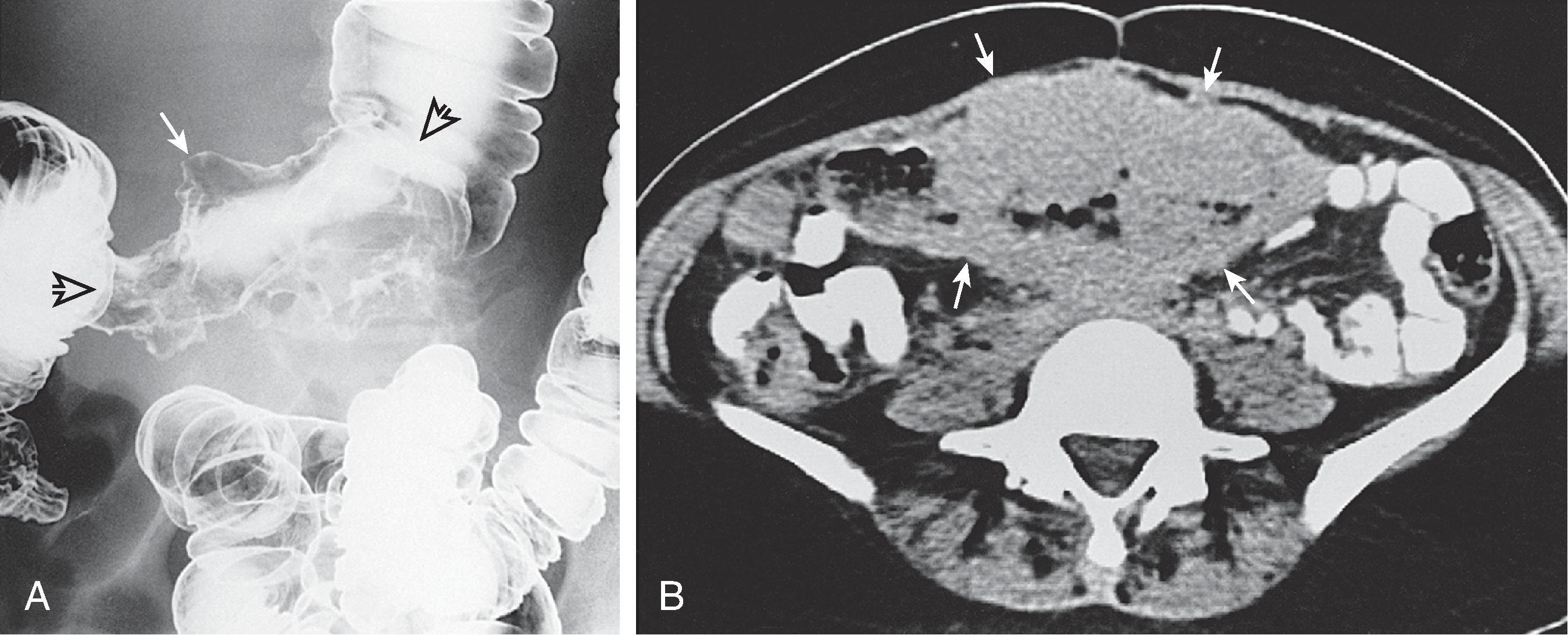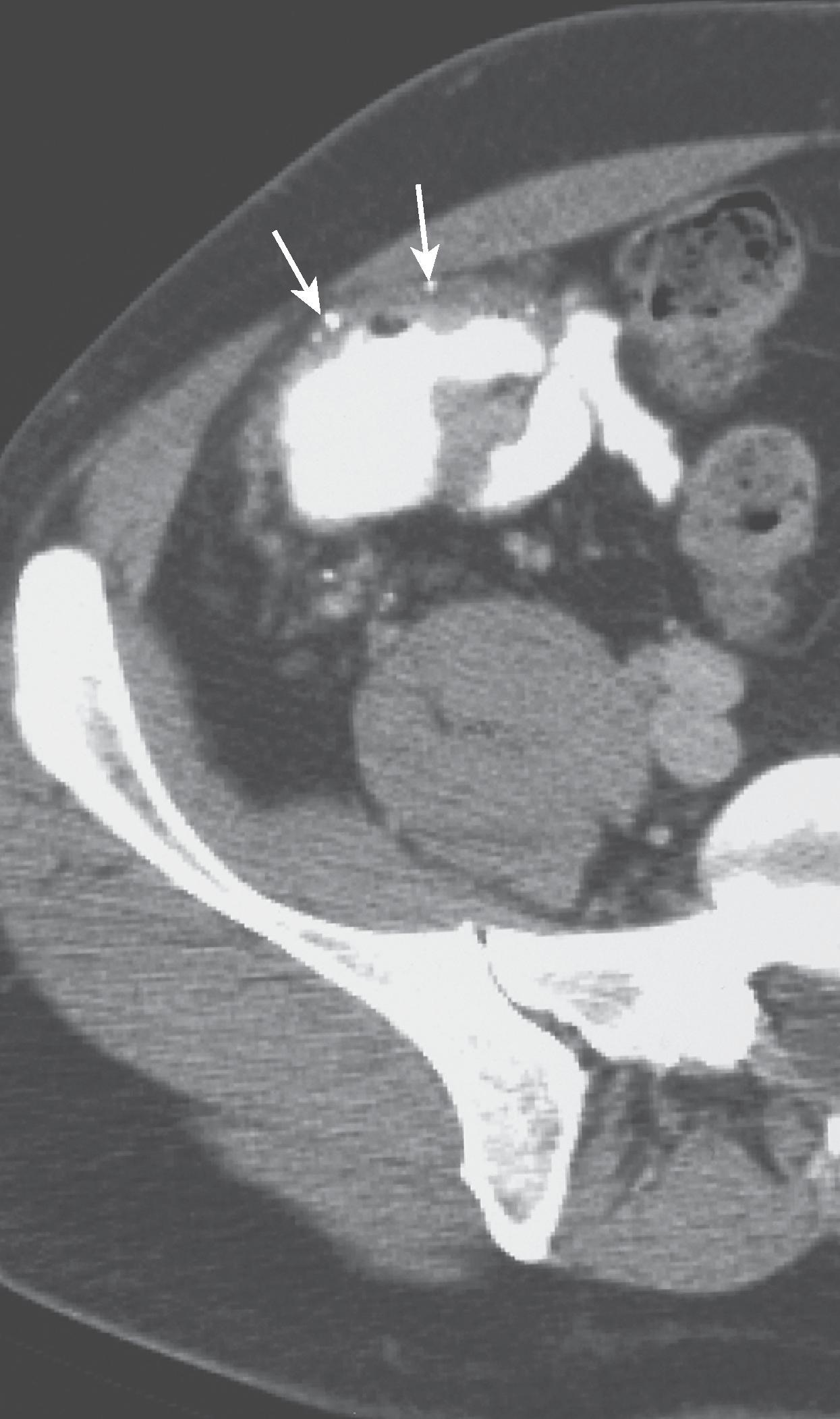Physical Address
304 North Cardinal St.
Dorchester Center, MA 02124
This chapter discusses a variety of benign and malignant tumors of the colon as separate entities. Although these tumors are associated with a wide range of clinical and radiologic manifestations, they may have typical features on imaging studies that suggest the correct diagnosis.
Malignant lymphomas involve the gastrointestinal (GI) tract as primary neoplasms or as part of a disseminated disease. The colon is the third most common primary site of lymphoma involving the GI tract (after the stomach and small bowel); colonic involvement occurs in 6% to 12% of cases. Primary lymphoma of the colon is rare, comprising less than 1% of all primary malignant tumors of the colon. Colonic involvement by systemic lymphoma is relatively common, with microscopic evidence of tumor in up to 44% of cases at autopsy. Primary colonic lymphoma is usually a B-cell lymphoma. Hodgkin’s lymphoma involving the colon is extremely rare.
Primary non-Hodgkin’s lymphoma involving the colon is usually seen in middle-aged or older persons. Abdominal pain, weight loss, and altered bowel habits occur in 60% to 90% of patients, and rectal bleeding or diarrhea occur in 25%. A palpable abdominal mass is the most frequent physical finding. Long-standing ulcerative colitis appears to be a predisposing condition, but the development of lymphoma in these patients may be related more to treatment with immunosuppressive agents than to the disease itself. Extranodal presentation of post-transplantation lymphoproliferative disorders is typical, and B-cell lymphomas may arise in the colon after solid organ transplantation. Anorectal lymphoma is seen in HIV-infected patients, but this has been decreasing in frequency.
The primary form of colonic lymphoma usually involves the ileocecal valve, cecum, or rectum. In contrast, systemic lymphoma usually involves the entire colon or long segments of bowel. , , The primary localized form of colonic lymphoma may be manifested by a variety of radiographic findings, including a polypoid or cavitary mass or circumferential mural lesion.
Bulky polypoid masses represent the most common form of primary colonic lymphoma. , , These tumors usually appear as smooth-surfaced, broad-based sessile lesions, with or without central depressions or ulcerations. These lesions vary from 4 to 20 cm in size and are usually located near the ileocecal valve. Extension of cecal lymphoma into the terminal ileum is not uncommon.
The annular infiltrating form of colonic lymphoma usually involves a long segment of colon, appearing as an annular narrowing or cavitary mass with thickened, irregular haustral folds and a lobulated surface pattern ( Fig. 44.1 ). Although the colonic lumen may be narrowed, obstruction is uncommon. Although the contour is irregular, the mucosal surface is smooth, suggesting submucosal infiltration rather than mucosal ulceration. Thus, the major considerations in the differential diagnosis of the annular infiltrating form of lymphoma include submucosal hemorrhage and edema (caused by ischemia or a bleeding diathesis) and an unusual colonic carcinoma.

Large infiltrating tumors may extend into the mesentery or exhibit central cavitation, resulting in a bulky, cavitary mass lesion. The major considerations in the differential diagnosis of the cavitary form of lymphoma include a perforated colonic carcinoma and a mesenchymal tumor, such as a GI stromal tumor (GIST).
The diffuse multinodular form of colonic lymphoma (lymphomatous polyposis) is associated with disseminated disease from a nodal primary lymphoma or occurs as a true primary GI lymphoma. Histologically, this form of lymphoma is usually a mantle cell lymphoma derived from a subpopulation of mantle zone cells. These multinodular lymphomas involve long segments of the colon or the entire colon. The small intestine may be simultaneously involved. More than 100 nonuniform, smooth, sessile nodules varying from 2 to 25 mm in size carpet the colonic surface. , The nodules are occasionally elongated, pedunculated, umbilicated, or filiform. A conglomerate cecal mass is seen in almost 50% of cases. Associated mesenteric lymph nodes are usually enlarged. The multinodular form of colonic lymphoma may be confused radiographically with familial polyposis, lymphoid hyperplasia, inflammatory bowel disease, or infectious diseases, such as pseudomembranous colitis or schistosomiasis. The nodules of colonic lymphoma are nonuniform and relatively large in comparison to the uniform, 1- to 2-mm nodules of lymphoid hyperplasia. Unlike the pseudopolyposis in inflammatory bowel disease, the haustral pattern is also preserved in colonic lymphoma, and ulceration is uncommon. Rarely, diffuse colonic lymphoma may be associated with acute toxic dilation or pneumatosis coli.
Hemangiomas of the colon are rare vascular lesions, but the radiologic diagnosis is important because these lesions may be misdiagnosed at endoscopy and have a high mortality rate related to severe GI bleeding. Patients with colonic hemangiomas usually present at a young age with acute, recurrent, or chronic rectal bleeding. Some patients may have severe, life-threatening rectal bleeding. Obstructive symptoms and diarrhea are uncommon, occurring in 15% to 20% of cases. Occasionally, patients with anorectal lesions may complain of tenesmus or constipation.
Cavernous hemangiomas are the most common form; capillary hemangiomas are second in frequency. Cavernous hemangiomas are unencapsulated lesions, usually arising in the submucosa. They are composed of large, multiloculated, thin-walled vessels separated by loose connective tissue. They usually occur in the rectum or sigmoid colon, appearing as discrete submucosal masses or, more frequently, as diffuse, infiltrative lesions. Polypoid tumors may intussuscept, causing obstruction, whereas infiltrative lesions often ulcerate and bleed.
Capillary hemangiomas usually occur as solitary, sharply circumscribed submucosal masses in asymptomatic patients. The tumors are composed of small vessels lined by well-differentiated endothelial cells. The vessels are packed together, with scant surrounding connective tissue. These tumors are occasionally associated with cutaneous or visceral hemangiomas. Colonic hemangiomas may occur in the Klippel-Trenaunay syndrome, manifested by the triad of cutaneous hemangiomas, soft tissue hypertrophy of the involved lower extremity, and congenital varicose veins. Cavernous hemangiomas of the colon are also seen in the blue rubber bleb nevus syndrome and in some patients with Peutz-Jeghers syndrome. Hemangiomas have also been reported in 5% to 8% of patients with Turner’s syndrome. Colonic hemangiomas have no propensity for malignant transformation and should, therefore, be distinguished from their true neoplastic counterpart, angiosarcomas.
Plain abdominal radiographs may show multiple phleboliths along the course of the bowel in 50% of cases. , Hemangiomas should, therefore, be suspected if abdominal radiographs demonstrate phleboliths in young patients with GI bleeding or clusters of phleboliths in atypical locations or along the expected course of the rectosigmoid colon.
Barium enema examinations usually reveal a circumferential lesion, with scalloped contours and a nodular mucosal surface pattern. The colonic lumen is narrowed in 50% of cases. If phleboliths are visible, they are seen in the expected location of the colonic tumor ( Fig. 44.2 ). The polypoid form of hemangioma is usually manifested by smooth, sessile, broad-based submucosal masses.

Computed tomography (CT) delineates the true dimensions of the mass (see Fig. 44.2 ) and involvement of adjacent structures, such as the urinary bladder. The presence of phleboliths should suggest the correct diagnosis.
Lymphangiomas of the colon are extremely rare benign lesions of neoplastic or hamartomatous origin. The lesions are composed of a cluster of lymphatic spaces lined by endothelial cells and separated by the connective tissue septa. These dilated lymphatics are usually found in the muscularis mucosae or submucosa. Some lymphangiomas arise in the colonic mesentery. Patients with colonic lymphangiomas usually present in the fourth to sixth decade of life with abdominal pain, rectal bleeding, watery diarrhea, and/or altered bowel habits. Lymphangiomas may appear radiographically as solitary, 2- to 4-cm, often pedunculated polypoid lesions or as smooth submucosal masses. On CT, a smooth unilocular or multilocular submucosal mass of water attenuation (0–20 HU) is seen.
Angiodysplasia is a common cause of chronic low-grade or acute massive lower GI bleeding in older patients. These lesions are acquired vascular ectasias, possibly caused by chronic, low-grade colonic obstruction. Angiodysplasias are composed of clusters of dilated, tortuous, thin-walled veins, venules, and capillaries localized in the colonic mucosa and submucosa. The mucosal layer overlying the vascular tuft may be thin or ulcerated. These lesions are single or multiple and small (usually <5 mm), usually found in the cecum or ascending colon.
Angiodysplasias may coexist with other causes of GI bleeding. These lesions have been found at autopsy in 2% of asymptomatic older patients and, in one series, angiodysplasias were present in the resected specimens in 12 of 15 patients who had undergone surgery for colonic carcinoma. Angiodysplasias are not associated with angiomatous lesions of the skin or other viscera.
Angiodysplasias may be detected at colonoscopy during the work-up of patients with severe or recurrent lower GI bleeding. If angiography is performed during the arterial phase, a focus of angiodysplasia usually appears as a tangle of small vessels at the end of a cecal or right colonic artery. Early filling of draining veins with contrast medium is usually seen, but extravasation of contrast medium rarely occurs.
Become a Clinical Tree membership for Full access and enjoy Unlimited articles
If you are a member. Log in here